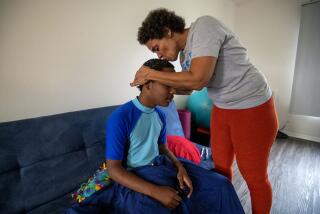Parents’ Love Beat All Odds to Give Baby Hope of Life
- Share via
Something in the modern world--probably the tyranny of logic--makes us hunger for stories about the triumph of blind faith over medical certainty.
This is why it’s hard to resist the story of the Churches, Tim and Sandy, who were told by doctors that their premature baby, Leah, was born with a severely underdeveloped brain. The baby, they were told, was sure to die.
Leah is now 8.
David King, a family practice doctor who has treated the girl and her family for the last two years in rural Montana, sees this as a tale with a kind of mythical attraction, a tale with deep cultural resonance.
“The story,” he said, “is that a mother refused to give up on her child, even when experts said there is no hope . . . The doctors were wrong . . . People revel in that.”
*
The Churches are not educated people, nor affluent. Tim works as a mechanic on one of the largest ranches in Montana, a few miles away from the Turner/Fonda spread. Sandy fell in love with him 10 years ago, when he wrestled a calf to the ground and sat on it so she could pet it.
“That is when I knew I loved him,” she said. She married him five weeks later. She was 19; he was 35.
On their first anniversary, she discovered she was pregnant. But two months before the baby was due, she went into labor.
The baby, born by Cesarean section at a Billings hospital, was whisked away. Sandy, combatting a life-threatening infection that resulted from the surgery, did not see Leah for five days. When she did, she was devastated.
“I took one look at her just went ‘ Uuuuh. ‘ I had never seen anything like that. I couldn’t believe I gave birth to a monster. It was a horrible sight. Her veins were popping out of head. She weighed 6 pounds, four ounces, but it was all head. Her length was 18 1/2 inches, and her head was 18 3/4 inches around.
“The doctors said they were surprised she was alive. They said she had no brain at all, that all she had was a brain stem. They told us about genetics counseling, that I was still young, that I could have another child.”
*
When Leah was two days old, a CT scan showed the presence of some brain tissue.
In one medical report, a doctor referred to Leah as “anencephalic,” a condition in which there is only a brain stem, nearly always fatal. Leah was not anencephalic.
Other reports diagnosed “hydrocephalus,” a condition also called “water on the brain,” which can be successfully treated by installing a shunt that drains fluid from the brain into the abdominal cavity. Like a sponge, the brain of a hydrocephalic child can be compressed by cerebrospinal fluid, making it difficult to know how much of the organ is present. This was Leah’s problem.
When Leah was a week old, a nurse told Sandy to insist that Leah be given a shunt, or fluid drain. Sandy didn’t know what a shunt was, but felt it was her only hope. Sandy said doctors argued it was pointless, but the hospital called neurosurgeon James H. Johnson Jr. for a second opinion. Dr. Johnson recommended that the baby be shunted.
“I knew if they didn’t do anything the child would not die,” said Johnson, “but would develop a very large head and be difficult to take care of.”
The Churches simply believed that a shunt would alleviate some of the child’s suffering, that it was only a way to help Leah’s enormous head stop growing so fast until she died.
A doctor who examined Leah at two weeks said the baby was probably blind, deaf and severely retarded. At two months, doctors said they could do no more for her. The Churches’ only question was whether to bring her home to die.
“They told us we should consider having them place her in an institution,” said Sandy. “If not, they said I would wake up one morning and find her dead. I didn’t want her. There was no way I could go through that. But my husband was telling me she didn’t ask to be born, that we brought her into this world, that it was our responsibility to keep her and we were the only ones that she had and we had to love her until she died.
“I was really angry and told him to get out my life. I threw him out of the hotel room. He walked up to the hospital and sat in a rocking chair next to her crib and picked her up and rocked her from 11 at night til the sun came up. In the morning, he came back to the motel and we walked back up to the hospital and told the doctors we were bringing her home to die.”
Actually, “home” was a misnomer, since they would spend the next several months in a motel near the hospital, where they took Leah every day to have her head drained with a syringe. For a time, they also manually pumped fluid from their’s daughter’s head, pressing on a one-way valve under the surface of Leah’s scalp that was part of the shunt. Sandy pumped days, Tim pumped nights--round the clock, they pumped, 200 times an hour.
The decision to keep Leah would have enormous financial repercussions on the family. Tim has lost more than one job because of the time he has dedicated to Leah’s care. The Churches, who have since had two other children, have sold most of what they owned, including a dozen cows that were to be the foundation of a herd that would give the family economic security. Last year, they declared bankruptcy.
But, they are quick to say, they regret nothing.
*
When Leah was 8 months old, Tim and Sandy noticed her eyes following them. When Sandy dropped a pan in the kitchen, Tim yelled that Leah had startled in the next room. Sandy marched the baby over to her doctors and insisted the child they said was deaf and blind was neither.
Doctors suggested psychiatric help for Sandy.
When Leah was 13 months old, an advocacy group for the disabled put them in touch with a pediatric neurologist, who confirmed for the Churches that Leah indeed had a brain.
“The only explanation we got is that she had brain all along, but all the fluid was flattening it like a sponge,” said Sandy. “By pumping her fluid and and bringing her in everyday to remove the fluid, it allowed the brain to expand. The doctor said it was because of Tim and I doing all the things that we did. We had taken her in every day of her life. They were always shaving off her hair and her head was alway red (from antiseptics). But it was worth it!
After Leah’s third shunt was installed, she began making dramatic developmental strides. She crawled at 3 1/2. She walked at four. At five, Leah began school, but only after a fight. The school claimed it did not have the facilities for a special needs child such as Leah, but Sandy just didn’t see Leah that way.
“She already knew how to write her name,” said Sandy. “She knew the alphabet.”
There was social pressure too. “Some families were calling us troublemakers. They said, ‘Why should our taxes go to educate your child who can’t learn anyways?’ ”
The family hired an attorney and the school backed down.
*
Today, Leah is a sweet-natured, plump 8-year-old, who attends second grade.
King, her doctor, said the child has a number of lingering problems, including an enlarged head, an abnormal gait and impaired eyesight. She is subject to seizures, though they are under control.
She is, he said, developmentally delayed. But in a phone conversation, she is a delightful child with an engaging personality and a slightly stubborn streak.
Two weeks ago, Leah competed in her first track meet, running a 50-meter dash and 50-meter relay.
“Leah,” said King, “continues to surprise people.”
The Churches like to call Leah their “miracle baby.”
The miracle, really, is not that Leah survived. The miracle is that her parents never gave up.






